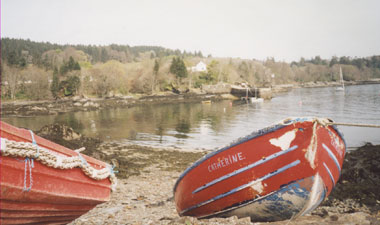|
‘The Great Glen' Tuesday 18 May
|
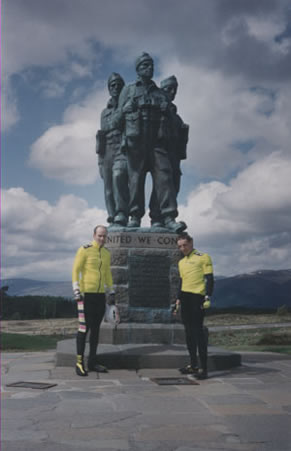
|
After lunch they continued into the wind along the left side of Loch Lochie heading for the Commando Memorial. The sun was out, intermittently and some low flying Hercules bombers on exercise droned noisily along the Glen, shattering the peace and quiet. Both R & R had the feeling that this part of the day's journey was just to be got through and with the anticipation of better things to come they continued up the great fault line that was the Great Glen.
They stopped to rest at the Commando memorial (with it's inscription united we conquer, pity our cycling wasn't!), which is a sculpture of three soldiers in bronze by Sutherland. Looking westward to Cameran country and Loch Eil where they trained during the war, it is magnificent. There was the spectacular view of the mountain range over which Ben Nevis, huge and forbidding – reigns. On again, the road now a little more sheltered, descending the Caledonian Canal constructed to a design by Thomas Telford with 28 locks. It enabled small ships to avoid the rough passage of Cape Wrath. The two intrepid cyclists took the Banavie byway (A 8004) which led to Fort William and which felt comparatively easy.
At the highest point of the Glen they passed Glengarry Castle and then the Well of the Seven Heads raised to commemorate the execution of seven brothers for murdering the son's of a seventeenth century Chief of Kepoch. Rod stopped frequently to take photographs, especially around Laggan Swing Bridge and the locks of the canal.
“Fort William was our halfway point of the day, 65 miles and seven and a half hours on the road. I felt we were going places now. We had coffee and then booked the night's accommodation in Acharacle through the Fort William Tourist Information Centre halfway up the high street in Camaran Square and also found out from a friendly member of staff, that we could catch the last foot ferry at 5.40pm across Loch Linnhe to Camusnagaul to take the quiet road to Strontian rather than the busy A82 to Corran and the ferry crossing from there”.
The ferry crossing was delightful in a small boat with the bikes (stripped of panniers) balanced precariously on the gangway. For five minutes, they put their feet up and Scotland watched them sail by.
|
|
The weather picked up as they disembarked and back across the Loch they could see the busy road to Corran that they had avoided. Conditions were easier, the wind was behind them now and with a renewed sense of purpose, they headed towards Clan Ranold Hotel. They turned westwards on a small track from Inversanda to Strontian over which the mountains loomed and the highlands of the Glencoe range could be seen clearly behind.
Gradually, the terrain became hillier and they climbed towards a mountain pass, the trough of the Glen Tarbert and descended to Loch Stuart and onto the delightful Moidart Coast,
|
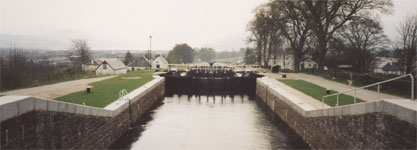 |
Rod thought that the sheep looked incredibly clean and white and found his whistle (safety whistle not mouth) very useful to clear them, and the odd cow of the road as they sped down. The undulating road wound in and out of the bays where the glistening sea crept into the land, held back by fantastic stonewalls. The sun was setting on the unspoilt, lush countryside, which seemed unchanged and timeless, peaceful under the pink and grey twilight sky (until these two rowdies on bikes whirred and whistled their way through!).
Arriving in Acharacle, they were told that the Hotel was a further 5 miles around the Loch, thankfully exaggerated because “it's the fastest five miles I have ever cycled” exclaimed Rod. The Hotel was small but the landlord was a canny chap and prepared poached salmon, late as it was (10.00pm). Both R & R felt spaced out; tired and a little queasy (through the bonk or the knock setting in) they forced the meal down and retired to sleep like proverbial logs.
|
|
‘The Moidart Coast' Wednesday 19 May
|
|
“It was 5.30am and very light with clear blue skies when I woke up. So I grabbed my camera and went for a short walk, leaving Rae asleep. I returned for breakfast then we paid up, packed up and we were on the road for about 8.00am. It felt chilly, the blue skies having clouded over and there was a light prevailing wind. But the scenery was amazing and we eased our legs at a reasonable pace towards Samalamen Bay by way of Glenuig”.
The cycling was hard through Glen Moidart the seat of the MacDonalds, with steep gradients on every climb and in places the road seemed to have been hewn out of the underlying rock. They saw historic cairns, apparently commemorating Bonnie Prince Charlie, but four of the seven Beeches at Glenuig (signifying seven clan leaders who helped BPC) had been blown down in the storms of 1988. Four saplings had been planted to replace them.
At Glenuig they took a slight detour past the Roman Catholic church of St Agnes to Samalamen Bay for magnificent views of the outlying Isles of Rum, Eigg and Muck. By now, the skies were clearing and the islands seemed wild and uninhabited on the horizon.
|
|
|
Returning to the route, the A861 road hugged the line of the coast, bordered in places by sheer, rocky cliffs dropping straight down to the sea below. Then pressed on to Arisaig, the weather becoming ever more glorious – sunny, clear and calm. The well-surfaced A830 road made the going fast and it weaved under and over the West Highland Railway. The sun flickered through the bosky dells and carpets of bluebells spread between the trees. On time, on course and with views of the sound of Arisaig, they arrived in the village of Arisaig to take lunch in the Old Library Tearooms. One and a half hours later, they hoisted themselves back onto the bikes for a hilly eight miles to Mallaig and the ferry to Skye. The weather had turned and it was grey, murky and drizzly although Rod managed to get some shots of white sands, the marram grass and macha of the Morar beaches. Loch Morar the deepest inland water at a depth of 1017 feet, there is no other water of this depth until 170 miles out between St Kilda and Rockall at the edge of the Continental shelf (they just saw the surface).
|
They arrived just in time for the one and a half hour ferry crossing to Armadale on Skye.
After disembarking, they cycled to ‘Skye Batiks', a shop selling all manner of things with Celtic prints on them. The owner (a guy called Gavin from Bradford) offered them coffee and chatted expansively about the success of his business. Rod bought a scarf for Alison.
It was late afternoon when they left Armadale but they felt there was enough time to do a detour recommended by Graham, which took in the two crafting villages of Tarskavaig and Ord.
|
 |
|
 |
So two miles from Armadale, they turned west on to a small lane, which led across an expanse of very barren, open moorland. By now, the rain was stair-rodding off the road but undeterred, the two donned waterproofs and with stinging eyes carried on up a long climb over the breadth of the island to the opposite coast, with Tarkavaig at the bottom of the corresponding descent.
Shrouded in lowering clouds and superbly dramatic, there was a view of all 23 peaks of the main horshoe of the Cuillin Hills.
|
It was on this descent that Rae amused Rod with his cornering technique, tri-bar assisted – skilfully bouncing off the road to do some rough stuff on the grass verge. Now they faced a tough 1 in 4 climb to Ord. En route they met a friendly! Village postie, who tried to run them off the road each time he passed them. Both villages were simply a few houses on the roadside, blink at the crucial moment and they were gone.
Getting back to the main A851 route meant conquering several stiff climbs and they both felt chilled and hungry, although the rain had stopped, momentarily. They regained the main route, with an easier ride to Broadford and views of the tidal Isle of Ornsay with it's lighthouse and the bleak moorland and mountains of Knoydart in the distance.
In Broadford an accommodating café-owning drunk opened up and them much needed tea and twixes. Leaving the café, admiring the open sewer, they headed into the mysterious wilds of the Red and Black Cuillin past ancient graveyards and lonely lochs. The clouds remained low and there was a strong headwind to battle against. The road wound it's way around Loch Slapin, skirting the looming Black Cuillins. The sight of the mountains and stormy waters under a threatening sky was unforgettable. Finally, after one last climb they passed through the wrought iron gates and up the gravel drive to Straithaird House, the Hotel for the night.
|
|
|
‘Skye & Harris' Thursday 20 May
|
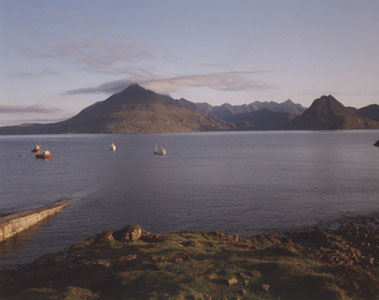 |
The day began with an early morning cycle out (on unladen bikes) to Elgol – 5 easy miles and perfect views of the keel shaped ridge of the Cuillins mirrored in Loch Scavaig. The first fishing boats could be seen leaving the harbour. The breathtaking view was followed by the breathtaking 1 in 4 climb back for breakfast.
After repacking the bikes they took the same road travelled the night before in stormy weather, this time it was in glorious sunshine – not a cloud to be seen. After the first climb it was down to T-shirts and shorts and a slap of sun cream. Looking out towards Dun Ringill, which inspired the song by Ian Anderson of Jethro Tull (who just happened to own a vast area of the surrounding land). At Loch Slapin they stopped to photograph once again the hills reflected in the loch and also the intense greeny-blue effect the water had due to the white sand from the local marble quarry having coated the bed of the loch. Through the binoculars they espied the first climbers ascending the ridges towards Blaven. It was tempting to change the day's itinerary and go walking in the pink granite and black gabro of the Cuillin instead! Remembering they are supposed to be the toughest in Britain (next time, Rod!).
At a fair pace they took the road to Broadford and then continued with a good tailwind to Portree taking the smooth coast road with, superb views of the Isle of Raasay on the right. The road began to rise before them in a long, steep ascent at it turned inland and it was here that Rae encountered ‘Les noisettes de cyclismo' when his chain came off and groin met crossbar ‘avec le crunch'. Rod was busy admiring the view from the top towards Lord MacDonald's forest.
|
|
The A850 road descended to Portree, with the Storr seen in the distance as the next landmark. Portree itself was a large, rather busy town with the coach park poorly situated in the centre – a hustling, bustling culture shock after the deserted miles covered. The name Portree derives from King's harbour, because in 1540 James V arrived here to try to end the feuds. It also houses the old Inn where Flora MacDonald bade her last farewell to Bonnie Prince Charlie. They had lunch and then Rae went to book the night's accommodation, leaving Rod to give the bikes the once over. Unfortunately, Rod discovered that his back pannier carrier had snapped and sorting it out cost valuable time (they found a bike shop in somebodies basement).
It was gone 3.00pm when they finally bade farewell to Portree and two scenic detours at the Storr and the Quiraing would have to be sacrificed. Eight miles from Portree on the A855 they passed the steep slopes of the Storr rising 2058 feet high, littered with tall chimney-stacks of volcanic rock including ‘The Old Man of Storr' an impressive 160 feet balanced on the edge of a green corrie below the cliffs. They continued on the main road to Staffin, catching the first glimpse of Harris and Lewis ahead over the Sound of Shiant – time pressing them forward. Rod was feeling rough here and tucked in behind Rae to shelter from the strong head wind.
|
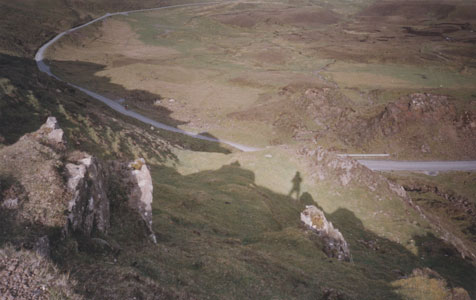 |
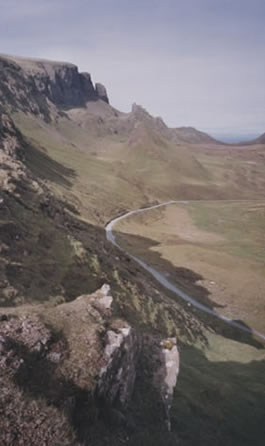 |
Reaching Staffin at about 5.00pm, they were dismayed to find that Uig (and the ferry to Harris) was still apparently another 17 miles away, although their route indicated only 8! With the last ferry crossing scheduled for 6.20pm, they stood at the crossroads wondering whether they should take the long main road or the Uig minor road, which seemed to ascend a sheer cliff! Out of the blue, a Tweedy Matey complete with brogues and perched on his sit-up-and-beg, appeared and reassured them that the minor road was the quickest way and he would ride with them for it's ascent. He joined Rae at the front, keeping up a good pace with Rae trying to hold a conversation with him.
When Rod recovered he moved to front with Tweedy Matey with Rae following, he proceeded to half-wheel Rod until Rae was a spec in the distance and sweat was dripping from Matey's brow. Eventually the pace and steepness proved too much and he turned to Rod saying he would “take it at his own pace” and got off and walked. Rod waited happily at the top, recovered and photographed the top of Rae's head. There was a brilliant view of the road snaking back with the sea and the mountains in bright sunshine. They sped down the welcome 5 mile descent over cattle grids and negotiating hairpin bends into the picturesque village of Uig with it's charming white rendered buildings crowded around a small harbour. They were in time for the ferry and enjoyed the reasonably calm, though cold, crossing.
|
Arriving at Tarbert mid evening (8.30ish pm). They had had an awful bacon butty on the ferry and so they set off straight away to avoid getting too cold. Their route was towards Luskentyre Sands on a minor road that climbed sharply out of Tarbert and then became more undulating.
The weather was clear and there was a marked difference in the scenery, a barren lunar landscape especially around Tarbert.
|
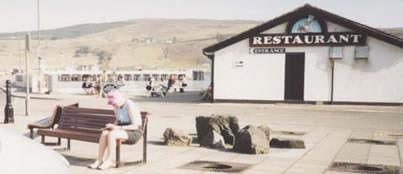 |
| Nothing seemed to be growing, just lonely stretches of water and grey rocks. It was eerie listening to the sound of skylarks ascending over this empty land. Gradually as the views of the sands appeared, the land became more lush and green with sheep grazing and lots of rabbits ambling around in the road. They skirted the coast on a smooth, flattish road – avoiding the rabbits that didn't even move for them and looking for the nine-holed golf course that denoted where the B & B was supposed to be. Rae phoned Caroline from an ancient phone box near Scarista Post office. |
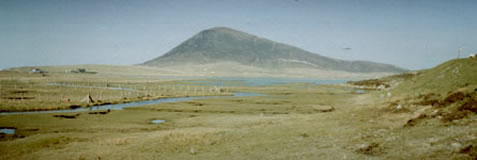 |
As they drew near their destination, the sun was setting in a pink glow over the Atlantic. In the west was the imaginary land of the ever young – Tor Nan Og. At last, after a very hard day they found the B & B, which overlooked Chiapaval. They recovered from their exertions with a cup of tea in the porch.
They ate late on boot leather chops and crashed out.
|
|
‘Harris & Lewis' Friday 21 May
|
They had a lie in till 6.30am and felt stronger and brighter. After breakfast they cycled 2 miles in the cold, cloudy morning along the isthmus bounded by golden sands and well populated by sheep. They hid their bikes and changed clothes ready for the short walk up Chiapaval. It was quite an easy climb to the top and, although the skies were cloudy, they had good views of the Island.
|
After returning to the bikes they headed south-east on the hilly coast road past Rodal Church (this reminded Rod for some reason, of the suburbs of Paris – something to do with the contrast between the houses and the countryside) and then turned north with golden bays on the right, towards Tarbert. The dark day and strong head wind prevented much appreciation of this view. It was a very hard road, referred to as the ‘Golden Road' it was grey and up and down, they relied on supplies of dried fruit to keep them going until 2.00pm when they reached Tarbert.
They had an excellent meal of steamed Halibut at the Harris Hotel and Rod met an Audax rider from Newcastle who had known Steve Nicholas – one of Rod's cycling friends from Rochdale who had been murdered in Africa.
|
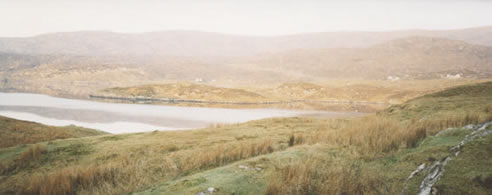 |
R & R left Tarbert at about 3.30pm to cross the Black Moor to Stornaway. The climb out of the town, past the working quarries with dumper trucks roaring and trundling over the land, was somewhat depressing. The road was in the process of being widened and the traffic passed at speed. There was nothing much to see and they both concentrated on reaching their destination. Approaching the harbour, the rain set in and (of course) the booking office was closed when they got there. “Oh dear” they said (or something to that effect) and took turns sheltering in a phone box. Eventually they decided to explore Stornaway and come back later. This they did and were told by an old chap, who was sweeping up that he could get them boarding cards. Following his instructions, they dashed on to the ferry when it docked and went to see the Steward and paid him for the tickets. He said they could leave their stuff and return when they had eaten. So they did this and then walked through Stornaway (which looked like Littleborough on a wet Saturday night) and found a curry house for a tartan rogan josh (discount for cash).
Afterwards they returned to the ferry and bedded down on the ‘comfy' chairs for the night – which never came because the lights were left on and so they slept fitfully until embarkation at 5.30am. The North Minch was perfectly still and Rod joined some bird watchers on deck to see what was what and saw dolphins in the distance leaping and diving in the early sunshine.
|
|
|
‘Stac Pollaidh' Saturday 22 May.
|
Rae joined Rod on the deck as the ‘Suilven' chugged past the Summer Isles. It was very cold and the shore was obscured by big, black, threatening clouds out of which snow capped tips of the mountains rose.
“Looking at the mainland, like this, I felt we were in for a really awful, cold, hard day I wasn't looking forward to it at all. We drew into Ullapool via Loch Broom and suddenly it was a midsummers day – blue, sunny and getting warm. The prevailing wind had banished the cloud and it was beautiful and inviting”.
They were very hungry and cycled straight to the Ceilidh Centre for breakfast and then shopped for provisions in readiness for the Stac Pollaidh ascent. There was a fairly steep climb out from Ullapool and then a tail wind accompanied them on a smooth road to Achiltiebuie where they joined the ‘old' single track road towards the coast for about 5 miles. Stac Pollaidh was distinctive on the skyline and drawing nearer.
A golden eagle glided overhead and the scent of gorse in full bloom filled the air with a tropical, coconut, perfume.
|
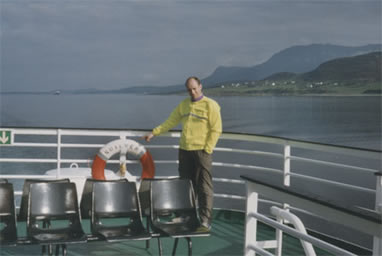 |
|
|
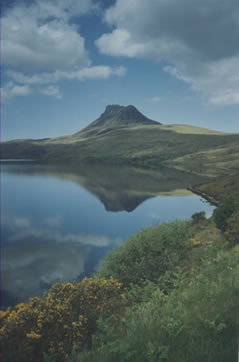
|
A sign indicated that we were in a nature reserve.After eating a fortifying second breakfast of muesli, they got changed, hid the bikes and headed for the summit.
The lower slopes were bracken covered before reaching the main track upwards. The ascent was easy on the well-worn track with excellent views all around – Suilven, the Summer Isles and the road dwindling into the distance towards Lochinver and an Alsation dog on the summit ahead. After a bit of a scramble they reached the summit and noticed other, more challenging climbs that could be attempted along the ridge and up the stacks and down chimneys and other strange rock formations for which Stac Pollaidh is reknowned. This audacious little peak, whilst not the height of a mountain is magnificent. They took lots of photographs and ate lunch before descending.
Once more on velo, after untangling the bikes from the bracken and gorse and a bungy cord. This caused an outburst from Rod that Rae referred to as “The Mount Bungy incident”. Their route continued right round to the north west side of Stac Pollaidh. The road was quite difficult zigzagging to the sea and back inland rising and falling with sharp gradients. At one point Suilven seemed to block the road off completely. Approaching Lochinver, they watched a heron catch an eel as they had a short rest on ‘the mad little road of Sutherland' and then made their way into a pretty village centred on a small harbour.
The Hotel and fish factory dominated one end; their B & B on a hillside was to be home for three nights and had wonderful views of Suilven and the Bay.
It was early evening with almost Mediterranean weather and they dined at an excellent Bistro on fresh fish and the finest wines known to man. Unfortunately, alcohol and tiredness led to some mutual irritability, so they went to bed early to ignore each other. |
|
|
‘Suilven' Sunday 23 May.
|
R & R ate breakfast and then set out in stony silence on foot to Suilven. The weather was gorgeous and it eventually it dawned on them that it was too nice for stony silences.
They took a single-track road, hedged by gorse bushes in full bloom and full of singing birds. About a quarter of a mile along, an old couple (also on their way to ascend Suilven) offered them a lift to the lodge, which was the start of the walk proper. Did they accept this offer of motorised transport?
The lodge formed a beautiful picture on the banks of the loch, surrounded by woods and Suilven soaring up into the blue sky. It was a six-mile walk along the footpath to the base of the mountain, where they stopped to eat. Then they began the ascent, on a less beaten track taking care of loose rocks on the scree slope up. Apart form the odd patch of cloud, it was clear and very hot.
On reaching the saddle at the top they traversed some hard and tricky terrain to the high cairn of the summit. From here the view was of course, breathtaking – looking out across the plain to the ridges of the mountains opposite (including Stac Pollaidh) and back to Lochinver and the mighty Quinnag. They spent over an hour on the summit, with Rae trying to get a suntan!
|
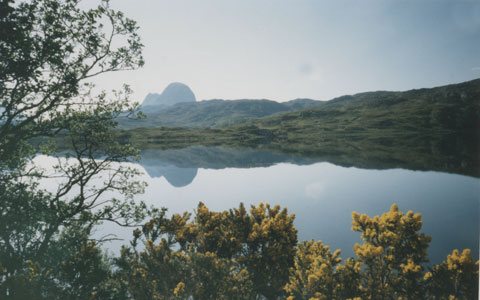 |
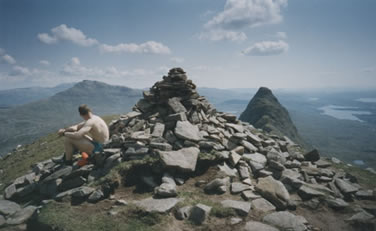 |
They retraced their steps back to the saddle on Suilven's ridge and went to investigate the well constructed stonewall, complete with a stile. Most strange – incredible to think of the work involved in building such a thing so high up and remote, seemingly useless! (on reflection it must have been a boundary wall). Continuing the descent, they passed a few people going up including the old couple.
The descent was very quick as they did some scree riding and running.
|
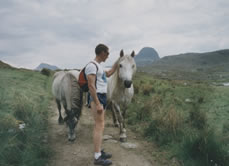 |
| Walking to the lodge, the white horses grazing at the lochside cantered through the spray towards them, Rae was enchanted. |
They walked back to Lochinver on the more scenic path – past the weir and through some woods. Called at the Bistro for fresh orange juice and cheesecake with moods much improved, sun burnt and pleasantly tired. Back to the B & B to shower and change, wash clothes and then back to the Bistro for a fine meal of soup, oatcakes, advocado, prawns, venison, halibut ‘banoffee' cake and coffee.
|
|
|
‘Drumbeg Scenic Route' Monday 24 May
|
They both rose at 5.00am and ate the cereals left out for them. Outside, the sky was brilliantly clear with Suilven picked out on the skyline above Lochinver Bay. Today was the ‘Drumbeg Scenic Route' – a much-vaunted difficult route for cyclists, which they would undertake on unladen bikes.
The first hill was hard; this was due more to stiff muscles than the steep gradient but after half an hour and a couple more climbs, things improved. Going towards Clashnessie Bay they found the going easier than anticipated – the climbs were neither too long nor too steep. They passed Stoer Bay with its lighthouse and rocky pinnacle known as…the Old Man of Stoer (have we heard that name before!). Because of the increasing heat of the day, haziness developed which gave the mountain views a strange two dimensional effect, almost as if they were cardboard cutouts. Through small villages, inlets and coves, weaving to and fro from the coast, they made their way to Drumbeg village.
They stopped at a coastal viewpoint outside the village for a snackette of Quiche and apple-pie. As they continued, the road began to live up to its reputation as it hugged the line of the coast with sharp descents and ascents and serpentine twists and turns.
|
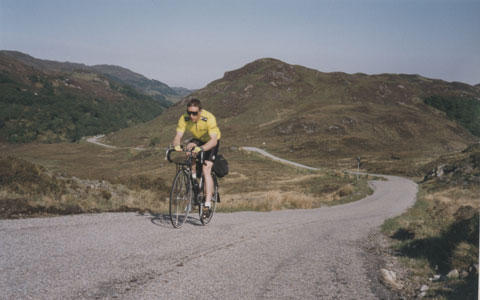 |
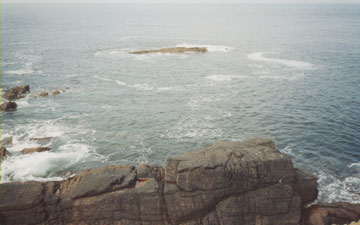 |
They both agreed that the worst ‘heave' was near the end where the road just went up at a 1 in 4. But overall, Rod's opinion was:
“I found the route much easier than we had feared – it were nowt like t'hills o'Yorkshire”.
The road wound round the foothills of the mighty Quinag lined with sweet smelling gorse. It was spectacular and the light here was fantastic, showing sharply etched shadows and a myriad of colours. Of course, all good things end and eventually they were back on the main road.
They went down to Kylesku for another breakfast at the recommended Hotel which had, unfortunately, changed hands and was a rip off - £6.45 for two coffees and two slices of toast. ('Nowt like t'teashops o'Yorkshire').
|
|
Afterwards, in true holiday spirit they decided to take a boat trip out to the East Coul Aulin Falls, in preference to the originally planned cycle and walk. The sun was beating down as they climbed into a small speed boat and motored to the centre of the Loch to a large salmon farm with the capacity for about a quarter of a million fish. It was at this point that the boat would not restart. After drifting for some time another boat was contacted and soon the Statesman was chugging towards them, and to the consternation of the day-trippers on board, as the two chappies in cycling gear hopped on! (It turned out that this was the official boat trip – the Hotel, another rip off, ran the first).
This was one of the high spots of the holiday. They had an excellent guide in the form of the Skipper Willy Watson who was very funny, although his description that part of the Loch was pinpointed as being the proposed sight of a super quarry left everybody dumbfounded. There was an island on which seals basked and a stag was glimpsed on the skyline and a golden eagle soared high looking down on them.
|

|
Back on shore R & R were invited to Willy's caravan for an excellent coffee, biscuits and a chat. Rae managed to recover the money given to the bogus boat man and passed it on to Willy.
The journey back to Lochinver, after a long climb, was fast and the last 11 miles were covered at an average speed of 22mph, although part of the road was being resurfaced and was a treacherous surface that was tricky to negotiate. Rod skidded across the road a number of times on the grit.
Back in Lochinver it was straight to the Bistro for fresh orange juice and cheesecake and then to the B & B where they prepared for tomorrow's departure and the evening meal. A stroll down to the Bistro (again), to enjoy the specially ordered Salmon and Dill mustard for Rod and Halibut for Rae and then early to bed because another 5am start was planned for the following day.
|
|
|
‘The Road to Durness' Tuesday 25 May
|
They were disappointed when they awoke at 5am to find the weather had changed. It was dull and cold with a strong blustery wind. After re-packing the panniers, loading up the bikes and checking everything thoroughly, whilst being eaten alive by midges. It was back to the road against a very strong headwind, it was a battle made worthwhile by the spectacular sight of rugged countryside and mountains shrouded in mist.
At Kylesku Bridge, not far from where they had taken the boat trip, it began to rain. They had to shelter in order to wrap up against the biting cold. They crossed the Bridge, newly built to replace the foot ferry and, after a long climb, reached the vantage point, which afforded fantastic views of the land over which they had cycled. Then they battled on for many miles to Scourie through the bleak, desolate moorland broken only by lonely stretches of water. They made one detour to the south shore of Loch Lexford where John Ridgeway has his outward-bound centre – which Rae had stayed at some years ago. It was possible to pick out many of the mountains on the distant horizon by name. The wind was becoming icy and they hit a difficult stretch approaching Durness of about 12 miles with no shelter at all with views of the coast curving away towards Cape wrath. Brr!
They arrived, wind blown and cold at Durness, which struck them as a ghost town, avoiding the tumbleweed blowing down the High Street, they ate at a ‘greasy sporran' type café (their Bistro-provided packed lunch of quiche and apple pie having been consumed on the way). Somewhat refreshed, they made their way around the coast, following the road as it skirted the shores of Loch Eribol. Soon they took a dirt track down to the Loch side to reach Port Na Con B & B, with a full view of the ominous Ben Hope; they realised that, with bad weather, this could be the worst climb of all.
However, that was yet to come and in the meantime Port Na Con was a delightful and very welcoming B&B that catered for vegetarians. The two set about their usual chores and had a look around the place before eating an excellent evening meal with lots of lemon meringue for dessert. (Rod eating the landlady's son's helping!). Afterwards all the guests retired to the lounge for a drink in a pleasant social atmosphere – especially an amusingly loud Dutchman.
|
|
|
‘A Day of Hope' Wednesday 26 May.
|
They slept in until 7am and rose to tuck into a fine breakfast of porridge and (distinctly non- vegie) haggis. They left Port Na Con at about 10.30am with a brisk northeast wind accompanying them on the long cycle around Loch Eribol, passing by the lonely phonebox. There were some stiff climbs en route and, at Eribol Farm, they passed the track originally pinpointed as a possible way to Ben Hope, but confirmed last night as uncyclable.
As the weather improved they found the small road to Ben Hope ahead and they were soon at the foothills. Strewn with huge boulders, which at some time or other had been dislodged from the mountain. It took some time to hide the bikes before starting on the 3,040foot ascent. Ben Hope was wilder than Suilven but the climb itself was easier than expected, taking around one and a quarter hours. At the summit, the mist restricted the views and it was bitterly cold. A friendly Glaswegian shared the summit and his tea and sandwiches with them. Afterwards they bade him farewell and made a fast descent, in 50 minutes to be exact.
Back on the seemingly endless Hope Road past Dun Dornadillo and into the empty wilds of Sutherland.
|
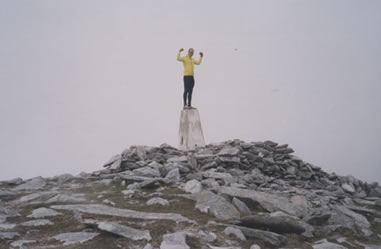 |
It was extremely hard going in dull, windy weather and they were relieved to arrive at Altnaharra, where even the phone box had had its red paint weathered off. They had tea and biscuits in a shooting lodge, wrapped up well before beginning the last leg of the day to Crask Inn. Expecting more of a battle, they were relieved to find themselves being pushed at speed, by the wind, to the Inn. It was a bit of run down but homely; the landlord seemed young and full of himself.
The hunger monster once again reared its head and R & R prepared to dine. Menus in hand, they proceeded to eat a huge main course and drink their fill of Glenlivet single malt in a celebratory ‘nearing the end' mood in front of an open fire which Rae managed to get roaring up the chimney (the fire not him!). They then proceeded to bring the landlord down a peg or two, when he brought the desserts menu, they said they would have the dessert after another main course he slunk back into the kitchen. After dessert they bedded down at 10.30pm.
|
|
|
‘The Last Day' Thursday 27 May
|
Their last day saw them up at 7am to an invasion of poachers, and the landlord still asleep (och - the youth of today). They left at 8.40am with conditions against them once more so that the downhill to Lairg through forestry plantations was a little slower than it should have been, although they made good progress on the ten-mile stretch to Bonar Bridge. This was a disappointing place in comparison to some of the places visited with run down seediness to it.
They had tea and twixes in an out of the way café chatting to the 73 year old proprieter about the Highland Clearances. Rae was pretty tired and at one point Rod noticed he was reading the map upside down. Then it was back on the road for the last real climb of Ross and Cromarty before returning to civilisation, and a distressingly busy road, at Dingwall (with a motorway on stilts disappearing over the estuary to their left. In Dingwall they stopped for lunch at a café in the pedestrianised area. A locally living Norwegian suggested an alternative, much nicer route to Inverness, which proved to be a fitting end to the journey because it took them away from the traffic on a scenic single track down side of the Beauly Firth.
The sun broke the grey clouds as they breasted the sharp climb up to the large bridge, which they crossed via the cycle lane in difficult conditions – a strong side wind made it a precarious ride – then it was straight into the city traffic. The two bemused travellers successfully negotiated the centre and, although they parted company briefly, they arrived at Flora MacDonald's statue together safe and sound at 4.30pm to complete the full circle of the ‘Tour Nan Og.
|
|
Bathed in sunshine it was time to reflect on the long, sometimes hard miles covered and the images crowding in of lochs, mountains and the Scottish coast. Then, with 4 hours until the train departure, a shower facility at Inverness Station was found and then to the Phoenix Inn (with it's sawdust and spittoons), followed by a quick pizza.
On the train, it was not long before they were sound asleep moving rapidly southwards. ‘To sleep perchance to dream'……… Rod dreamt of climbing an impossibly steep mountain in appalling conditions, turning to his work colleague Graham to urge him on…..
Rae suggested that it's meaning was obvious “ It's called getting back to work, mate”. And so it was thus.
|
Your Tweedy Matey's fun
You sit him on his bike
And then he'll pedal like hell
Until he's lost from sight
He went out one day
Just for a pleasant ride
And whom should he encounter?
But Rod and Rae, side by side.
Matey sat up tall
Relishing the challenge
These two boys, he thought
“I'll pip them to the top” (Scottishness)
Up the steep incline
Matey tried his best
But before he'd got halfway
He had got off muttering
“I'll do it at ma own pace” (Scottishness) |
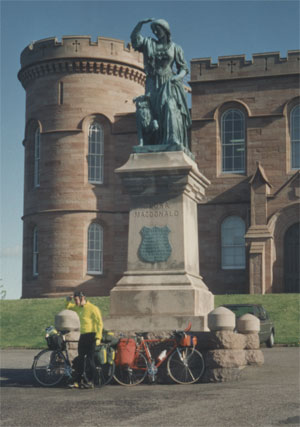 |
|



